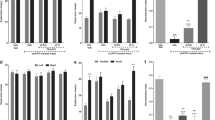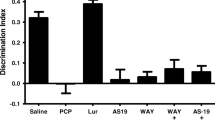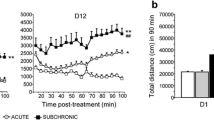Abstract
Rationale
Reversal learning (RL), a type of executive function, dependent on prefrontal cortical function, is impaired in rodents by subchronic (sc) treatment with the N-methyl-d-aspartate receptor antagonist, phencyclidine (PCP), a widely studied model of cognitive impairment in schizophrenia (CIS).
Objective
The principal objective of this study was to determine the ability of serotonin (5-HT)1A partial agonism and 5-HT7 receptor antagonism to improve RL in scPCP-treated mice.
Methods
Male C57BL/6J mice were trained on an operant RL (ORL) task, then received PCP, 10 mg/kg, or saline, bid, for 7 days, followed by a 7-day washout period.
Results
scPCP significantly diminished the percent correct responding, increased total incorrect trials, and total incorrect responses, in the reversal phase performance of the ORL task. Pre-treatment with the selective 5-HT1A partial agonist, tandospirone, or the selective 5-HT7 antagonist, SB269970, but not the 5-HT7 agonist, AS 19, reversed the scPCP-induced deficit in RL. Pre-treatment with atypical antipsychotic drug lurasidone, which is a 5-HT1A partial agonist and 5-HT7 antagonist, as well as a 5-HT2A and dopamine (D)2 antagonist, also reversed RL deficit in the scPCP-treated mice. Furthermore, the selective 5-HT1A antagonist, WAY100635, blocked the ability of lurasidone to reverse the scPCP-induced RL deficit.
Conclusions
These results indicate that 5-HT7 antagonism and 5-HT1A partial agonism contribute to restoration of RL in scPCP-treated mice. It is suggested that these two mechanisms are effective in restoring RL by decreasing excessive GABAergic inhibition of cortical pyramidal neurons following withdrawal of scPCP treatment.



Similar content being viewed by others
Abbreviations
- AAPD:
-
Atypical antipsychotic drug
- CIAS:
-
Cognitive impairment in schizophrenia
- DA:
-
Dopamine
- EF:
-
Executive functioning
- FR:
-
Fixed ratio
- GABA:
-
Gamma amino butyric acid
- mPFC:
-
Medial prefrontal cortex
- NMDAR:
-
N-methyl-d-aspartate receptor
- NOR:
-
Novel object recognition
- ORL:
-
Operant reversal learning
- PCP:
-
Phencyclidine
- RL:
-
Reversal learning
- sc:
-
Subchronic
References
Abdul-Monim Z, Reynolds GP, Neill JC (2003) The atypical antipsychotic ziprasidone, but not haloperidol, improves phencyclidine-induced cognitive deficits in a reversal learning task in the rat. J Psychopharmacol 17(1):57–65
Abdul-Monim Z, Reynolds GP, Neill JC (2006) The effect of atypical and classical antipsychotics on sub-chronic PCP-induced cognitive deficits in a reversal-learning paradigm. Behav Brain Res 169(2):263–273
Alsio J, Nilsson SR, Gastambide F, Wang RA, Dam SA, Mar AC, et al. (2015) The role of 5-HT receptors in touchscreen visual reversal learning in the rat: a cross-site study. Psychopharmacology
Beique JC, Campbell B, Perring P, Hamblin MW, Walker P, Mladenovic L et al (2004) Serotonergic regulation of membrane potential in developing rat prefrontal cortex: coordinated expression of 5-hydroxytryptamine (5-HT)1A, 5-HT2A, and 5-HT7 receptors. J Neurosci 24(20):4807–4817
Birrell JM, Brown VJ (2000) Medial frontal cortex mediates perceptual attentional set shifting in the rat. J Neurosci 20(11):4320–4324
Boulougouris V, Glennon JC, Robbins TW (2008) Dissociable effects of selective 5-HT2A and 5-HT2C receptor antagonists on serial spatial reversal learning in rats. Neuropsychopharmacology 33(8):2007–2019
Brady AM, Floresco SB (2015) Operant procedures for assessing behavioral flexibility in rats. J Vis Exp 96, e52387
Brigman JL, Ihne J, Saksida LM, Bussey TJ, Holmes A (2009) Effects of subchronic phencyclidine (PCP) treatment on social behaviors, and operant discrimination and reversal learning in C57BL/6J mice. Front Behav Neurosci 3:2
Celada P, Puig MV, Artigas F (2013) Serotonin modulation of cortical neurons and networks. Front Integr Neurosci 7:25
Chen L, Yung KK, Chan YS, Yung WH (2008) 5-HT excites globus pallidus neurons by multiple receptor mechanisms. Neuroscience 151(2):439–451
Choi YK, Snigdha S, Shahid M, Neill JC, Tarazi FI (2009) Subchronic effects of phencyclidine on dopamine and serotonin receptors: implications for schizophrenia. J Mol Neurosci 38(3):227–235
Chung YC, Li Z, Dai J, Meltzer HY, Ichikawa J (2004) Clozapine increases both acetylcholine and dopamine release in rat ventral hippocampus: role of 5-HT1A receptor agonism. Brain Res 1023(1):54–63
Clark L, Cools R, Robbins TW (2004) The neuropsychology of ventral prefrontal cortex: decision-making and reversal learning. Brain Cogn 55(1):41–53
Cools R, Roberts AC, Robbins TW (2008) Serotoninergic regulation of emotional and behavioural control processes. Trends Cogn Sci 12(1):31–40
D’Esposito M, Postle BR (2015) The cognitive neuroscience of working memory. Annu Rev Psychol 66:115–142
Davis KL, Kahn RS, Ko G, Davidson M (1991) Dopamine in schizophrenia: a review and reconceptualization. Am J Psychiatry 148(11):1474–1486
Egerton A, Allison C, Brett RR, Pratt JA (2006) Cannabinoids and prefrontal cortical function: insights from preclinical studies. Neurosci Biobehav Rev 30(5):680–695
El-Ghundi M, O’Dowd BF, George SR (2007) Insights into the role of dopamine receptor systems in learning and memory. Rev Neurosci 18(1):37–66
Enomoto T, Tse MT, Floresco SB (2011) Reducing prefrontal gamma-aminobutyric acid activity induces cognitive, behavioral, and dopaminergic abnormalities that resemble schizophrenia. Biol Psychiatry 69(5):432–441
Eriksson TM, Golkar A, Ekstrom JC, Svenningsson P, Ogren SO (2008) 5-HT7 receptor stimulation by 8-OH-DPAT counteracts the impairing effect of 5-HT(1A) receptor stimulation on contextual learning in mice. Eur J Pharmacol 596(1–3):107–110
Fineberg NA, Potenza MN, Chamberlain SR, Berlin HA, Menzies L, Bechara A et al (2010) Probing compulsive and impulsive behaviors, from animal models to endophenotypes: a narrative review. Neuropsychopharmacology 35(3):591–604
Gasbarri A, Cifariello A, Pompili A, Meneses A (2008) Effect of 5-HT(7) antagonist SB-269970 in the modulation of working and reference memory in the rat. Behav Brain Res 195(1):164–170
Green MF, Kern RS, Heaton RK (2004) Longitudinal studies of cognition and functional outcome in schizophrenia: implications for MATRICS. Schizophr Res 72(1):41–51
Hagan JJ, Price GW, Jeffrey P, Deeks NJ, Stean T, Piper D et al (2000) Characterization of SB-269970-A, a selective 5-HT(7) receptor antagonist. Br J Pharmacol 130(3):539–548
Hagger C, Buckley P, Kenny JT, Friedman L, Ubogy D, Meltzer HY (1993) Improvement in cognitive functions and psychiatric symptoms in treatment-refractory schizophrenic patients receiving clozapine. Biol Psychiatry 34(10):702–712
Harvey PD (2015) The clinical utility of lurasidone in schizophrenia: patient considerations. Neuropsychiatr Dis Treat 11:1103–1109
Harvey PD, Ogasa M, Cucchiaro J, Loebel A, Keefe RS (2011) Performance and interview-based assessments of cognitive change in a randomized, double-blind comparison of lurasidone vs. ziprasidone. Schizophr Res 127(1–3):188–194
Harvey PD, Siu CO, Hsu J, Cucchiaro J, Maruff P, Loebel A (2013) Effect of lurasidone on neurocognitive performance in patients with schizophrenia: a short-term placebo- and active-controlled study followed by a 6-month double-blind extension. Eur Neuropsychopharmacol 23(11):1373–1382
Homberg JR (2012) Serotonin and decision making processes. Neurosci Biobehav Rev 36(1):218–236
Horiguchi M, Meltzer HY (2012) The role of 5-HT1A receptors in phencyclidine (PCP)-induced novel object recognition (NOR) deficit in rats. Psychopharmacology 221(2):205–215
Horiguchi M, Huang M, Meltzer HY (2011) The role of 5-hydroxytryptamine 7 receptors in the phencyclidine-induced novel object recognition deficit in rats. J Pharmacol Exp Ther 338(2):605–614
Horiguchi M, Hannaway KE, Adelekun AE, Huang M, Jayathilake K, Meltzer HY (2013) D(1) receptor agonists reverse the subchronic phencyclidine (PCP)-induced novel object recognition (NOR) deficit in female rats. Behav Brain Res 238:36–43
Huang M, Horiguchi M, Felix AR, Meltzer HY (2012) 5-HT1A and 5-HT7 receptors contribute to lurasidone-induced dopamine efflux. Neuroreport 23(7):436–440
Huang M, Panos JJ, Kwon S, Oyamada Y, Rajagopal L, Meltzer HY (2014) Comparative effect of lurasidone and blonanserin on cortical glutamate, dopamine, and acetylcholine efflux: role of relative serotonin (5-HT)2A and DA D2 antagonism and 5-HT1A partial agonism. J Neurochem 128(6):938–949
Ichikawa J, Ishii H, Bonaccorso S, Fowler WL, O’Laughlin IA, Meltzer HY (2001) 5-HT(2A) and D(2) receptor blockade increases cortical DA release via 5-HT(1A) receptor activation: a possible mechanism of atypical antipsychotic-induced cortical dopamine release. J Neurochem 76(5):1521–1531
Idris N, Neill J, Grayson B, Bang-Andersen B, Witten LM, Brennum LT et al (2010) Sertindole improves sub-chronic PCP-induced reversal learning and episodic memory deficits in rodents: involvement of 5-HT(6) and 5-HT (2A) receptor mechanisms. Psychopharmacology 208(1):23–36
Ishibashi T, Horisawa T, Tokuda K, Ishiyama T, Ogasa M, Tagashira R et al (2010) Pharmacological profile of lurasidone, a novel antipsychotic agent with potent 5-hydroxytryptamine 7 (5-HT7) and 5-HT1A receptor activity. J Pharmacol Exp Ther 334(1):171–181
Javitt DC (2012) Twenty-five years of glutamate in schizophrenia: are we there yet? Schizophr Bull 38(5):911–913
Jentsch JD, Dazzi L, Chhatwal JP, Verrico CD, Roth RH (1998) Reduced prefrontal cortical dopamine, but not acetylcholine, release in vivo after repeated, intermittent phencyclidine administration to rats. Neurosci Lett 258(3):175–178
Kargieman L, Riga MS, Artigas F, Celada P (2012) Clozapine reverses phencyclidine-induced desynchronization of prefrontal cortex through a 5-HT(1A) receptor-dependent mechanism. Neuropsychopharmacology 37(3):723–733
Krystal JH, Karper LP, Seibyl JP, Freeman GK, Delaney R, Bremner JD et al (1994) Subanesthetic effects of the noncompetitive NMDA antagonist, ketamine, in humans. Psychotomimetic, perceptual, cognitive, and neuroendocrine responses. Arch Gen Psychiatry 51(3):199–214
Kuroki T, Meltzer HY, Ichikawa J (1999) Effects of antipsychotic drugs on extracellular dopamine levels in rat medial prefrontal cortex and nucleus accumbens. J Pharmacol Exp Ther 288(2):774–781
Laurent V, Podhorna J (2004) Subchronic phencyclidine treatment impairs performance of C57BL/6 mice in the attentional set-shifting task. Behav Pharmacol 15(2):141–148
Lewis DA, Volk DW, Hashimoto T (2004) Selective alterations in prefrontal cortical GABA neurotransmission in schizophrenia: a novel target for the treatment of working memory dysfunction. Psychopharmacology 174(1):143–150
Lisman J (2012) Excitation, inhibition, local oscillations, or large-scale loops: what causes the symptoms of schizophrenia? Curr Opin Neurobiol 22(3):537–544
Lynch G, Rex CS, Chen LY, Gall CM (2008) The substrates of memory: defects, treatments, and enhancement. Eur J Pharmacol 585(1):2–13
McLean SL, Idris NF, Woolley ML, Neill JC (2009a) D(1)-like receptor activation improves PCP-induced cognitive deficits in animal models: implications for mechanisms of improved cognitive function in schizophrenia. Eur Neuropsychopharmacol 19(6):440–450
McLean SL, Woolley ML, Thomas D, Neill JC (2009b) Role of 5-HT receptor mechanisms in sub-chronic PCP-induced reversal learning deficits in the rat. Psychopharmacology 206(3):403–414
Meltzer HY (2015) Attention must be paid: the association of plasma clozapine/NDMC ratio with working memory. Am J Psychiatry 172(6):502–504
Meltzer HY, Huang M (2008) In vivo actions of atypical antipsychotic drug on serotonergic and dopaminergic systems. Prog Brain Res 172:177–197
Meltzer HY, McGurk SR (1999) The effects of clozapine, risperidone, and olanzapine on cognitive function in schizophrenia. Schizophr Bull 25(2):233–255
Meltzer HY, Sumiyoshi T (2008) Does stimulation of 5-HT(1A) receptors improve cognition in schizophrenia? Behav Brain Res 195(1):98–102
Meltzer HY, Horiguchi M, Massey BW (2011) The role of serotonin in the NMDA receptor antagonist models of psychosis and cognitive impairment. Psychopharmacology 213(2–3):289–305
Meltzer HY, Rajagopal L, Huang M, Oyamada Y, Kwon S, Horiguchi M (2013) Translating the N-methyl-d-aspartate receptor antagonist model of schizophrenia to treatments for cognitive impairment in schizophrenia. Int J Neuropsychopharmacol 16(10):2181–2194
Meneses A (2004) Effects of the 5-HT7 receptor antagonists SB-269970 and DR 4004 in autoshaping Pavlovian/instrumental learning task. Behav Brain Res 155(2):275–282
Murai T, Nakako T, Ikejiri M, Ishiyama T, Taiji M, Ikeda K (2013) Effects of lurasidone on executive function in common marmosets. Behav Brain Res 246:125–131
Nabeshima T, Mouri A, Murai R, Noda Y (2006) Animal model of schizophrenia: dysfunction of NMDA receptor-signaling in mice following withdrawal from repeated administration of phencyclidine. Ann N Y Acad Sci 1086:160–168
Nagai T, Murai R, Matsui K, Kamei H, Noda Y, Furukawa H et al (2009) Aripiprazole ameliorates phencyclidine-induced impairment of recognition memory through dopamine D1 and serotonin 5-HT1A receptors. Psychopharmacology 202(1–3):315–328
Neill JC, Barnes S, Cook S, Grayson B, Idris NF, McLean SL et al (2010) Animal models of cognitive dysfunction and negative symptoms of schizophrenia: focus on NMDA receptor antagonism. Pharmacol Ther 128(3):419–432
Newcomer JW, Farber NB, Jevtovic-Todorovic V, Selke G, Melson AK, Hershey T et al (1999) Ketamine-induced NMDA receptor hypofunction as a model of memory impairment and psychosis. Neuropsychopharmacology 20(2):106–118
Nikiforuk A (2015) Targeting the serotonin 5-HT7 receptor in the search for treatments for CNS disorders: rationale and progress to date. CNS Drugs 29(4):265–275
Nikiforuk A, Kos T, Fijal K, Holuj M, Rafa D, Popik P (2013) Effects of the selective 5-HT7 receptor antagonist SB-269970 and amisulpride on ketamine-induced schizophrenia-like deficits in rats. PLoS One 8(6), e66695
Nomura T, Oyamada Y, Fernandes HB, Remmers C, Xu J, Meltzer H, et al. (2015) Subchronic phencyclidine treatment in adult mice increases GABAergic transmission and LTP threshold in the hippocampus. Neuropharmacology
Perez-Garcia GS, Meneses A (2005) Effects of the potential 5-HT7 receptor agonist AS 19 in an autoshaping learning task. Behav Brain Res 163(1):136–140
Rajagopal L, Massey BW, Huang M, Oyamada Y, Meltzer HY (2013) The novel object recognition test in rodents in relation to cognitive impairment in schizophrenia. Curr Pharm Des
Robbins TW (2005) Chemistry of the mind: neurochemical modulation of prefrontal cortical function. J Comp Neurol 493(1):140–146
Robbins TW, Arnsten AF (2009) The neuropsychopharmacology of fronto-executive function: monoaminergic modulation. Annu Rev Neurosci 32:267–287
Royall DR, Lauterbach EC, Cummings JL, Reeve A, Rummans TA, Kaufer DI et al (2002) Executive control function: a review of its promise and challenges for clinical research. A report from the Committee on Research of the American Neuropsychiatric Association. J Neuropsychiatry Clin Neurosci 14(4):377–405
Saykin AJ, Shtasel DL, Gur RE, Kester DB, Mozley LH, Stafiniak P et al (1994) Neuropsychological deficits in neuroleptic naive patients with first-episode schizophrenia. Arch Gen Psychiatry 51(2):124–131
Shallice T, Burgess P (1996) The domain of supervisory processes and temporal organization of behaviour. Philos Trans R Soc Lond Ser B Biol Sci 351(1346):1405–1411, discussion 1411–1402
Shimizu H, Karai N, Hirose A, Tatsuno T, Tanaka H, Kumasaka Y et al (1988) Interaction of SM-3997 with serotonin receptors in rat brain. Jpn J Pharmacol 46(3):311–314
Smith EE, Jonides J (1999) Storage and executive processes in the frontal lobes. Science 283(5408):1657–1661
Sun YN, Wang T, Wang Y, Han LN, Li LB, Zhang YM et al (2015) Activation of 5-HT1A receptors in the medial subdivision of the central nucleus of the amygdala produces anxiolytic effects in a rat model of Parkinson’s disease. Neuropharmacology 95:181–191
Tanaka E, North RA (1993) Actions of 5-hydroxytryptamine on neurons of the rat cingulate cortex. J Neurophysiol 69(5):1749–1757
Taylor SF, Tso IF (2014) GABA abnormalities in schizophrenia: a methodological review of in vivo studies. Schizophr Res
Tokarski K, Kusek M, Hess G (2011) 5-HT7 receptors modulate GABAergic transmission in rat hippocampal CA1 area. J Physiol Pharmacol 62(5):535–540
Wesolowska A, Kowalska M (2008) Influence of serotonin 5-HT(7) receptor blockade on the behavioral and neurochemical effects of imipramine in rats. Pharmacol Rep 60(4):464–474
Woodward ND, Purdon SE, Meltzer HY, Zald DH (2005) A meta-analysis of neuropsychological change to clozapine, olanzapine, quetiapine, and risperidone in schizophrenia. Int J Neuropsychopharmacol 8(3):457–472
Yuen EY, Li X, Wei J, Horiguchi M, Meltzer HY, Yan Z (2012) The novel antipsychotic drug lurasidone enhances N-methyl-d-aspartate receptor-mediated synaptic responses. Mol Pharmacol 81(2):113–119
Acknowledgments
We thank Dr. Sunoh Kwon for his assistance with drug preparations and Mr. Daniel Barrett Share for editorial assistance.
Author information
Authors and Affiliations
Corresponding author
Ethics declarations
Conflict of interest
Herbert Y Meltzer has received grant support from and been a consultant to Sumitomo Dainippon, Sunovion, Janssen, Novartis, ACADIA, Ferrosan, Roche, Takeda, Pfizer, Eli Lilly, EnVivo, Reviva, Alkermes, Astellas, Jazz, Solvay, SureGene, and Bristol Myers Squibb. Herbert Y Meltzer has been a consultant to Lundbeck and Teva. Herbert Y Meltzer is a shareholder of ACADIA, SureGene, and Astra Zeneca. Lakshmi Rajagopal, Bill Massey, and Eric Michael do not have any conflict of interest.
Support
This research is supported by a grant from Sumitomo Dainippon Pharma Co., Ltd.
Rights and permissions
About this article
Cite this article
Rajagopal, L., Massey, B.W., Michael, E. et al. Serotonin (5-HT)1A receptor agonism and 5-HT7 receptor antagonism ameliorate the subchronic phencyclidine-induced deficit in executive functioning in mice. Psychopharmacology 233, 649–660 (2016). https://doi.org/10.1007/s00213-015-4137-1
Received:
Accepted:
Published:
Issue Date:
DOI: https://doi.org/10.1007/s00213-015-4137-1




